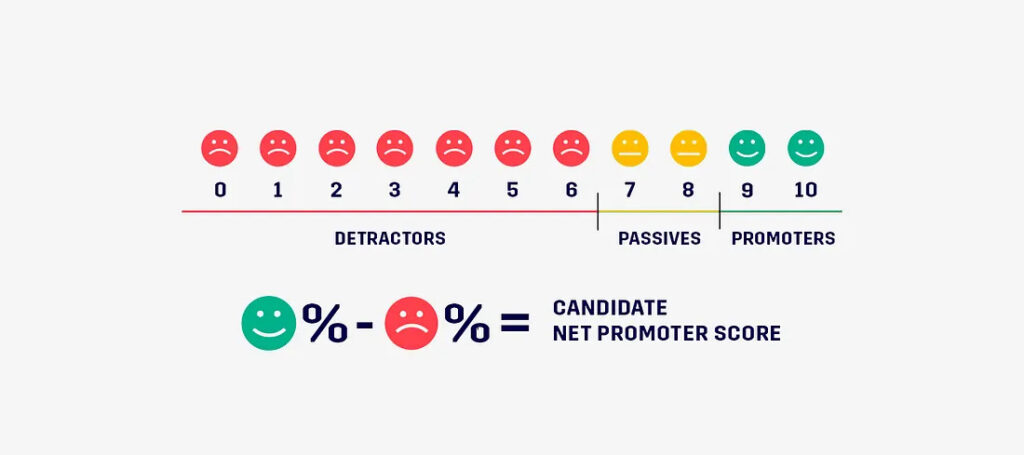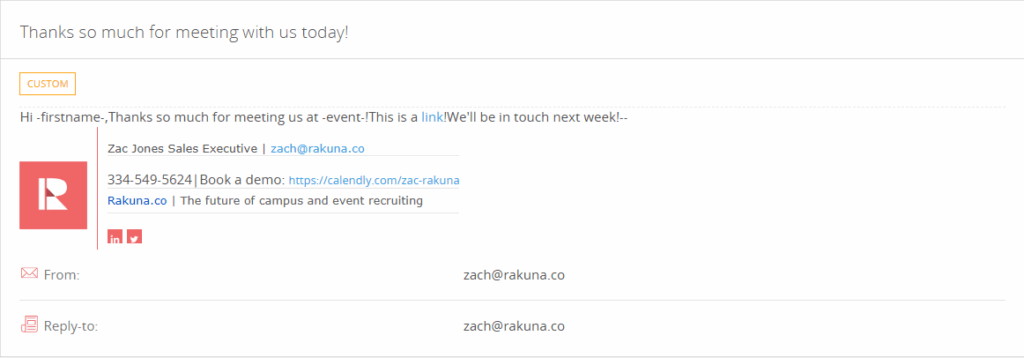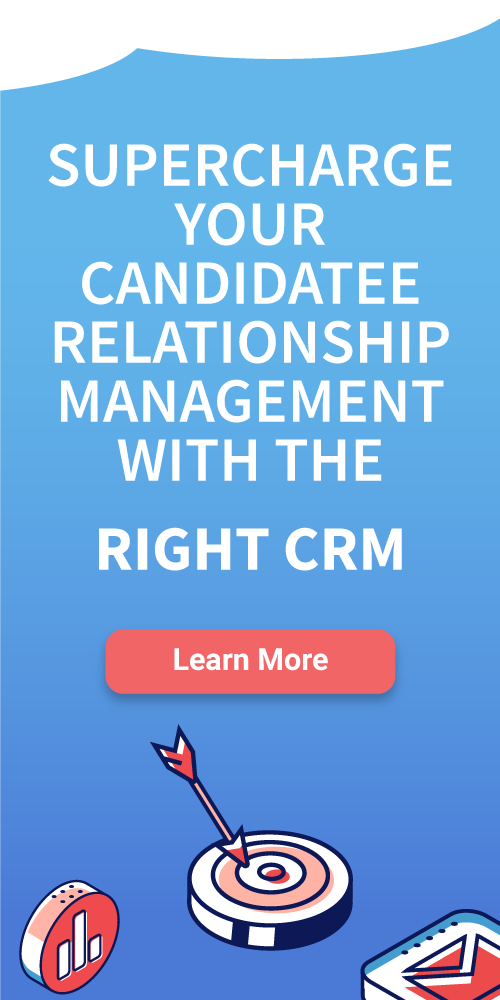An exceptional candidate experience (CX) is critical for large organizations vying for qualified talent. Today’s candidates are savvy consumers: They do their homework, form opinions quickly, and don’t hesitate to share their experiences—good or bad—with their networks.
💡In fact, 83% of candidates tell friends or family about a negative experience, and over half take it public on social media.
But here’s the upside: when the experience is great, candidates are more likely to stay engaged, accept offers, and feel aligned with the roles they land in.
That’s why we created this hands-on, practical candidate experience checklist tailored for enterprise-scale recruiting teams, designed to help you not just measure CX, but improve it in ways that scale. Each step includes implementation ideas, best practices, and real-world data to bring the strategy to life.
✅ Candidate Experience Checklist #1: Define What Success Looks Like

Before you can improve candidate experience, you have to define what it means for your organization—and how you’ll know when you’re getting it right.
That starts with strategy. Not just a vague ambition to “be nicer to candidates,” but a clear, measurable connection between candidate experience and your broader business goals.
Think about what matters most to your company: is it hiring faster? Attracting more diverse talent? Reducing reneges or boosting offer acceptance? Whatever your priorities, candidate experience plays a role—and it’s time to make that role visible.
Start by aligning your Candidate Experience (CX) metrics with outcomes your leadership cares about. That might mean tracking:
- Candidate Net Promoter Score (cNPS)
alongside
- Time-to-fill, cost-per-hire, quality-of-hire, or diversity targets.

A simple 0–10 question like “How likely are you to recommend applying to our company to a friend?” can serve as a high-level pulse check. But don’t stop there. Pair that score with operational data:
- Application completion rates, drop-off points, interview satisfaction, and offer acceptance rates.
This combination will give you a more nuanced picture of where the experience is breaking down.
And don’t forget about response rates. Starred’s Global Benchmarks Report – having surveyed 1.5M individuals with hiring experiences – tells us that candidate feedback isn’t always easy to get:
💡 Average response rates hover around 24% overall, with hired candidates responding closer to 50%, but rejected candidates only around 21%. Knowing these baselines helps set realistic expectations and goals.
Here’s where it all comes together: tie your metrics to a clear, measurable goal – your “North Star.” That could be improving your candidate Net Promoter Score (cNPS) by 10 points over the next six months or cutting down negative feedback by 20%.
The key is alignment. Get leadership on board early by connecting your goals to outcomes they care about – like faster hiring, stronger brand reputation, or improved offer acceptance rates. And once the work begins, share your progress. When executives see that candidate experience impacts business results, they’re far more likely to champion—and invest in—it.
How to Put It into Practice
Let’s bring together the right people: talent acquisition leaders, hiring managers, analytics teams, and define your key performance indicators (KPIs). Decide on your measurement rhythm: quarterly surveys? Post-interview feedback? Withdrawn-candidate outreach?
Pick the right tools, too. Your applicant tracking system (ATS) might offer feedback modules, or you might integrate with specialized platforms that automate survey triggers and pull data into visual dashboards.
💡 For example: When candidates capture candidates’ resume data through the Rakuna Optical Character Recognition AI or complete a candidate survey form customized through the Rakuna Event and Campus Recruiting Software, collected data will be collated into detailed but highly intuitive dashboards and report charts for review.
The key is scalability – whatever you choose should work across teams, regions, and roles without becoming another manual task.
Best Practices to Set Yourself Up for Success
- Make every metric actionable. For cNPS, always include open-text follow-ups to understand why someone gave a particular score.
- Context matters. Use industry benchmarks—like those from Talent Board or Starred—to see how your scores stack up.
- Connect the dots. Improving candidate experience should lead to better offer acceptance, lower renege rates, and ultimately better hires. Make those links visible.
As one industry summary puts it,
And they’re right. Tracking and improving cNPS over time isn’t just good for candidates, it makes the ROI of CX tangible to your exec team.
Because at the end of the day, what gets measured gets improved. And when you measure the right things, the candidate experience becomes a lever, not a liability.
✅ Candidate Experience Checklist #2: See the Experience Through Their Eyes

If you really want to improve candidate experience, you have to walk a mile in their shoes. That means understanding exactly what your candidates go through—from the moment they spot your brand to the day they accept (or decline) your offer.
That’s where journey mapping comes in.
Think of it like a blueprint of every interaction a candidate has with your company: the job ad that first caught their eye, the career site where they explored your culture, the application form, screening calls, interviews, assessments, offer letters, and onboarding. It’s all part of the journey, and every step shapes their perception.
For large or complex organizations, this process might reveal that there’s not one journey, but many. Candidates for executive roles in Europe might have a very different experience from hourly applicants in North America. That’s okay. The goal isn’t to standardize every detail—it’s to understand the full picture and spot where things are working (or not).
Mapping the journey also shows you where experiences break down.
- Maybe your application form is too long.
- Maybe interview feedback takes too long to arrive.
- Or maybe candidates drop off after an assessment because they don’t understand what it’s for.
Without a map, it’s hard to know.
Research from AIHR highlights seven key moments that matter most:
- The career page
- The application process
- Screenings phase
- Interview phase
- Assessments phase
- The offer
- and the transition into onboarding.
You are looking at opportunities to either build trust or lose it.
How to Make It Happen
Set up a collaborative workshop. Bring in recruiters, hiring managers, operations folks, and if you can, even past candidates. Together, map out each stage of the journey, including what a candidate is likely thinking, feeling, and expecting at each point.
Use flowcharts or swimlane diagrams to keep it visual and easy to follow. And don’t forget to document variations for different roles, regions, or business units. What’s intuitive for tech hiring might fall flat in frontline roles.
Once you have the journey mapped, look for natural moments to collect feedback. When do candidates tend to disengage? Where do misunderstandings happen? This will help you design smarter surveys (more on that in Step 4) and create a feedback loop that’s actually useful.
Best Practices to Get More Value from Journey Mapping
- Think end-to-end. The journey doesn’t end at the offer. Onboarding, rejections, and even post-hire check-ins all shape the candidate’s memory of the process.
- Tag your feedback. If you’re collecting surveys after key stages (like interviews or offers), tag the data by stage. This makes it easier to diagnose specific issues.
- Assign ownership. Marketing owns your career page. TA owns communication. Hiring managers own the interview experience. Make responsibilities clear so improvements stick.
It’s a logical assumption that
“Every Candidate expects an easy application process, prompt communication, and thoughtful interactions at each stage.”
When you take time to understand the journey from their perspective, you stop guessing and start designing experiences that actually benefit both parties.
Because ultimately, great experiences aren’t built in isolation. They’re built by understanding the full journey, moment by moment.
✅ Candidate Experience Checklist #3: Make It Easy to Say “Yes”

First impressions count toward success. And in recruiting, that first impression often comes the moment a candidate decides to apply. But here’s the problem: most of them don’t.
92% of candidates abandon the application process before hitting “submit.”
Some will see this as a simple loss opportunity – Other recruiting professionals consider them a flashing red sign that something in your process is turning people away.
Why? Often, it’s death by a thousand clicks. Think: mandatory account creation, endless form fields, cryptic job descriptions, or a process that feels better suited to desktop in 2005 than mobile in 2025.
If you want to create a standout candidate experience, start by reducing friction at the application stage. It should be quick, intuitive, and respectful of the candidate’s time.
A strong rule of thumb? Only ask what you actually need at this point. Name, contact info, resume. That’s it. Thanks to resume parsing or LinkedIn autofill, most of this can happen in under a minute.
If you need more data – say, behavioral questions or skills assessments, move those to later stages when the candidate is already more engaged.
How to Put It into Practice
Walk through your own application process like a mystery shopper. Start from Google or your careers site and try applying for a role. Was it fast? Was anything confusing? Did it work smoothly on your phone?
Then start removing hurdles like mandatory sign-ins or complex logins. Enable social sign-ons or Google single sign-on (SSO) and one-click applications. Cut unnecessary fields—if you’re not using it in screening, don’t ask for it.
Also, take a hard look at your job descriptions. Are they clear? Do they actually describe the role and your culture, or are they stuffed with jargon and wish lists?
In the AIHR’s “7 key CX moments in the recruitment process”, 71% of candidates want job ads that are transparent about company culture and expectations. Give them that.
Best Practices That Boost Completion Rates
- Set a clear benchmark. Aim for under 15 minutes to apply. Bonus points if you can proudly say “Apply in under 10!”
- Use progress bars. If your form can’t be shortened, at least show candidates how far along they are.
- Optimize for mobile. Many candidates are applying from their phones—make sure your process works seamlessly across devices.
- Offer human support. In high-volume or enterprise settings, equip recruiters to send short application links or even walk candidates through the process on a call.
Every click, every delay, every unclear instruction adds friction, and friction adds drop-off. And when 9 out of 10 candidates don’t complete the process, that’s more than just a bad experience—it’s bad for business.
When you simplify the application flow, you don’t just improve the experience—you increase conversion, reduce cost-per-hire, and shorten time-to-fill. Talent data from Appcast confirms that the more complicated your process, the more candidates you lose.
So if you’re looking for a quick CX win, this is it. Cut the clutter. Respect candidates’ time. And make it as easy to apply as it is to fall in love with your brand.
✅ Candidate Experience Checklist #4: Capture Feedback While It’s Fresh

Imagine going through a hiring process, hitting “submit” on your application, or walking out of an interview, and then hearing… nothing. Not even a “How did that go for you?”
It’s a missed opportunity. Because right at those moments, when impressions are still fresh and emotions are high, you have a window to learn what’s working and what isn’t.
That’s why leading organizations don’t wait until the end of the hiring process to collect feedback. They embed short, real-time surveys at key touchpoints: right after someone applies, after a phone screen, following interviews, and once a final decision is made.
This isn’t just about gathering data. It’s about signaling that you care. Candidates feel heard, and you gain insight into their experience before issues become patterns.
How to Build Feedback Into the Journey
Start by integrating short surveys into your ATS or CRM workflows. These can be triggered automatically based on stage changes, so every candidate gets a voice, whether they’re hired or not.
Choose a survey tool that plays nicely with your tech stack—whether it’s Qualtrics, SurveyMonkey, or native features in your ATS. Then set up templates tailored to each step: think “post-application,” “post-interview,” and “post-offer” surveys. Keep them brief—three to eight questions max—to respect your candidates’ time.
And remember: this isn’t a performance review. It’s about experience. So mix rating-scale questions with a single open-ended one like, “What’s one thing we could improve?”
Best Practices for Better Response and Better Data
- Ask at the right time. Immediate follow-ups are more accurate than end-of-process retrospectives.
- Keep it short and focused. Ask only what you truly need to know—think clarity of communication, ease of process, fairness, and how candidates were treated.
- Include a Candidate Net Promoter Score (cNPS) question—“How likely are you to recommend us to a friend?”—as a high-level indicator.
- Make participation easy. Mobile-friendly design and no logins required.
- Consider small incentives. A raffle for a gift card or a simple thank-you message can nudge response rates upward.
- Don’t forget the silent majority. An “always-on” feedback widget on your careers site can catch thoughts from candidates who didn’t formally apply.
Every good marketer knows feedback isn’t just for fixing what’s broken – It’s also a source of positive reinforcement. Sometimes, candidates will tell you what went really well. That insight can help you double down on what makes your hiring experience shine – and generate positive social content to hook in young talent.
Yes, global survey response rates hover around 24%, and even lower for rejected candidates. But the act of asking, done respectfully, already improves perception. One recruiting leader summed it up perfectly:
“Just being asked about their experience has an immediate, positive effect.”
✅ Candidate Experience Checklist #5: Leverage Automation

When gathering feedback from thousands of candidates, asking the right questions is not your only concern – the process also has to be effortless, repeatable, and scalable. That’s where automation becomes your best friend.
At enterprise scale, manual outreach quickly breaks down, no matter how hard you track or try to stick to the plan. Instead, build automated survey workflows directly into your ATS or candidate relationship management (recruiting CRM) system.

💡 Rakuna’s client, for example, has been sending out feedback requests automatically after key moments, like after an interview, rejection, or offer acceptance, with our Recruiting CRM to ensure every candidate gets a voice.
How to Make the Most Out of Your Automation
Start by integrating surveys into your recruiting processes. Most modern ATS platforms (like iCIMS or Workday) or CX tools (like Qualtrics, Starred, or Survale) allow you to trigger surveys based on candidate stage changes. For example, configure an automated rule to send a “post-interview” survey one day after the interview is completed, or a “rejection” survey 24 hours after a decline notice goes out.
Use dashboards to monitor feedback as it comes in—these real-time insights can help flag patterns and identify pain points early.
To keep things manageable, consider segmenting your audience. You might sample certain candidate groups (e.g., high-volume hourly roles) or focus more frequent surveys on strategic or hard-to-fill positions.
Best Practices to Get More from Automations
- Keep surveys mobile-friendly and on-brand so they’re easy to complete and feel like a natural extension of your candidate experience.
- Personalize survey invitations when possible—include the candidate’s name, role applied for, or the interviewer’s name to increase open rates.
- Use gentle reminders to boost completion. A single automated follow-up can significantly improve participation.
- Translate surveys into relevant languages if you hire across multiple regions or markets.
- Consider light incentives, like entry into a gift card raffle, to increase response rates, especially among rejected candidates.
Even a small reward can double participation, particularly in regions or roles where survey fatigue is common. A structured, scalable system ensures more consistent, representative feedback.
To acquire reliable data you can act on, one best practice you should always follow is optimizing both the email invite click-through rate and survey completion rate.
✅ Candidate Experience Checklist #6: Ask the Right Questions

When it comes to candidate feedback, less is often more. The best surveys don’t overwhelm, they focus on what really matters, ask at the right moment, and respect the candidate’s time.
Instead of a laundry list of questions, zero in on the themes that tie directly to your candidate experience goals:
- Was the job description clear?
- Did the recruiter communicate effectively?
- Did the interview process feel fair?
These are the insights that help you improve—and they’re the ones candidates are most willing to give.
Open-ended questions are equally important. A simple prompt like “Is there anything else you’d like to share?” often uncovers powerful nuance, things a rating scale can’t capture.
💡 And if you’re using a Candidate Net Promoter Score (cNPS), always follow it with a “why?” so you can understand what’s driving the score.
How to Start Asking the Right Questions (At the Right Time)
Start by building a question bank tailored to different touchpoints – application, interview, rejection, and offer. For instance, after an interview, ask about the interviewer’s professionalism and preparedness. Post-rejection, ask about the clarity of communication and whether the next steps were made clear.
Rotate in new questions occasionally to explore areas like perceived inclusivity or employer brand impressions—but don’t overload every survey. If possible, pilot your questions with a small internal group first to ensure clarity and tone.
Best Practices When Crafting Questions
- Keep it short. Aim for 4–8 questions per survey.
- Balance quantitative and qualitative. Use Likert scales or NPS ratings for easy tracking, and include one or two open-text boxes for depth.
- Tailor questions by stage. Interview candidates are best positioned to assess experience and communication. Passive candidates sourced via outbound might give better feedback on your brand perception.
- Use micro-pulses when needed. For example, insert a one-question survey after a pre-employment assessment asking, “How did that step feel to you?” It’s low lift but adds valuable context.
PeopleScout and others have found that the most effective surveys are short, specific, and tightly aligned with business objectives. One standout format: an NPS-style question plus a free-text comment. It’s quick for candidates and rich in insight for you.
Too many questions, or ones that feel irrelevant, cause drop-off or half-hearted responses. The key is thoughtful design over volume.
✅Candidate Experience Checklist #7: Analyze Feedback & Identify Patterns

Feedback collection is just the starting point, the real value comes when you dig into the data and start spotting patterns. That’s where insights turn into action.
Whether you’re gathering hundreds or thousands of survey responses, it’s important to build a consistent rhythm for reviewing and interpreting the feedback. Think of it like running a regular diagnostic on your recruiting engine.
- Are candidates feeling more positive about interviews this quarter compared to last?
- Is there a sudden drop in satisfaction for a particular business unit or region?
These trends, once surfaced, help you prioritize where to intervene and what to improve.
How to Kickstart Your Feedback Review Task?
Start by setting a regular schedule for analysis – monthly or quarterly works well, depending on volume. Use the reporting tools built into your survey platform, ATS, or business intelligence system to break down results by funnel stage, recruiter, role type, or geography.
For open-text responses, use text analytics tools to identify common keywords and sentiment. Words like “confusing,” “slow,” or “excellent” often pop up repeatedly, and they’re clues. Tag themes and set up alerts for recurring complaints, like “no feedback after interview” or “unclear job description.”
And don’t forget to track movement over time. If satisfaction scores improved after implementing recruiter training or a new scheduling tool, that’s a win worth celebrating—and repeating.
Best Practices During Your Review
- Use dashboards or scorecards to present insights clearly. Visualize CX metrics by stage (application, interview, offer) and compare across departments or time periods.
- Benchmark your data: either against past performance or external reports like Talent Board’s candidate experience benchmarks.
- Normalize your analysis for role type or region. Entry-level warehouse roles and executive tech hires won’t have the same expectations or experiences.
- Highlight the narrative, not just the numbers. Present trends as stories: “Interview satisfaction dropped in Q3 due to panel availability delays—intervention planned.”
Monitoring candidate experience KPIs can give organizations an edge when “pinpointing areas needing enhancement.”
Case-in-point:
💡 Elastic, a large tech firm, used feedback analysis to spot inconsistent interviewer behavior. After implementing targeted training, they saw a measurable improvement in candidate ratings.
Candidate feedback is one of your richest sources of truth, but only if you listen closely. When you analyze trends with intention, you stop guessing and start making data-backed decisions that move the needle.
✅Candidate Experience Checklist #8: Communicate Changes

One of the fastest ways to build trust with candidates? Let them know you’ve heard them – and you’re doing something about it.
Too often, candidate feedback goes into a black hole. Surveys are sent, data is collected, but the candidates who offered their thoughts never hear what came of it. Closing the loop flips that script. It turns passive data collection into a meaningful dialogue. Whether it’s sharing improvements on your careers site or simply sending a note to acknowledge a candidate’s input, small actions go a long way.
Thoughtful, timely responses (especially after interviews or rejections) demonstrate professionalism and respect. The best recruiters don’t just ask for feedback – they give it back.
What to Do When Communicating Feedback to Candidates
Start by incorporating feedback summaries into your internal communications. When survey data surfaces an issue, like delays in scheduling or unclear job descriptions, communicate the fix. Let stakeholders know what’s changing, and tell candidates what’s improving.
For example, a follow-up email might say:
“Thanks to your feedback, we’re introducing structured interviewer guides to improve consistency.”
This shows candidates their voices matter and invites them into the improvement process.
Internally, bring candidate feedback into recruiter huddles, TA dashboards, or hiring manager debriefs. Use anonymized quotes to humanize the data and spotlight moments that need attention or celebration.
Best Practices for Better Communication
- Acknowledge feedback visibly: on your careers page, in blog posts, or even in interview prep materials.
- Empower recruiters to follow up personally with candidates who invested significant time, particularly in senior or hard-to-fill roles.
- Investigate red flags quickly. If multiple candidates mention that an interviewer was distracted or dismissive, don’t wait – coach or retrain as needed.
- Train hiring managers on their feedback scores and comments, so they understand the impact of their behavior.
💡 And the results speak for themselves. CBA, a global brewing company, found that after implementing candidate feedback loops, an impressive 91% of candidates said they’d recommend the company to others, regardless of hiring outcome.
Closing the loop transforms candidate experience from a monologue into a conversation. It signals that you’re a company that values transparency, growth, and mutual respect. In a competitive hiring market, that kind of culture speaks volumes—and candidates notice.
✅ Candidate Experience Checklist #9: Elevate The Recruiter

At the heart of every candidate experience is a person. And more often than not, that person is an interviewer/recruiter.
No matter how sleek your career site or efficient your apply flow is, one awkward or unprepared interview can tank the whole experience. That’s why investing in your interviewers and giving them the tools to show up with confidence, empathy, and consistency – is essential.
Survey feedback is your guide here. If candidates mention vague questions, rushed interactions, or unclear expectations, don’t let that slide. Turn those comments into coaching moments.
Companies like Elastic did just that, launching a formal Interviewer Training Program after discovering inconsistencies in feedback.
Improve Your Recruiting Team With These Simple Steps
Make feedback actionable. During regular TA reviews, highlight trends in candidate sentiment – positive and negative – and share them with interviewers. Collect simple resources like “Top 5 Interview Tips” or “Common Candidate Pain Points” to raise awareness and begin benchmarking.
Offer optional (but encouraged) interview training programs, whether through e-learning modules, group coaching sessions, or quick reference guides for busy hiring managers. Make it easy to do better.
Consider tying candidate feedback into performance metrics for recruiters and interviewers. Spotlight those who consistently score well, perhaps with recognition programs like “Candidate Experience Champion of the Month.”
Best Practices When Training Your Recruiters
- Standardize training at the enterprise level. Teach foundational skills like active listening, inclusive interviewing, and structured assessment.
- Use rubrics or interview scorecards to guide consistency across departments and regions.
- Promote two-way engagement. Remind interviewers they’re not just evaluating candidates—they’re representing your brand.
- Leverage high performers. Let your best interviewers mentor others or contribute to training content.
Candidates don’t just remember what you asked—they remember how you made them feel. Elevating the quality of interviewer interactions sends a clear message: We value your time, your effort, and your potential. And when that message lands, candidates are more likely to say yes, more likely to refer others, and more likely to come back—even if they don’t get the role.
✅ Candidate Experience Checklist #10: Track Social & Reviews

Here’s the truth: candidates talk. And in today’s world, they talk publicly on Glassdoor, Indeed, LinkedIn, Reddit, and TikTok. Every review, comment, or post is a window into how your employer brand is perceived, whether you’re listening or not.
This is why passive listening is just the tip of the iceberg. You need an active approach to monitoring what candidates are saying about your hiring process, culture, and communication.
💡 Tools like Google Alerts, Hootsuite, or Sprout Social can help surface mentions in real time. Review platforms like Glassdoor can quickly flag if something’s off, say, a spike in complaints about ghosting or poor interview prep.
Listening to what’s said outside your own walls is critical for a complete view. Combine that external sentiment with your internal surveys, and you’ve got a powerful, 360-degree feedback loop.
Implementation Steps to Begin Active Listening
Set up a regular schedule – ideally daily or weekly – for top channels like Glassdoor, Indeed, and LinkedIn. If resources are tight, delegate this to a brand or communications team, or consider a third-party reputation management partner.
Then feed insights into your broader CX dashboards. Track sentiment scores, ratings, or recurring keywords. For example, if reviews mention “confusing interview stages” multiple times, cross-check that with internal candidate surveys to validate the trend.
And when necessary, respond professionally, promptly, and with empathy. Even a short acknowledgment can demonstrate that your organization takes feedback seriously.
Best Practices for Active Social Listening
- Be proactive. Don’t wait for a PR crisis. Monitor trends and respond before negative sentiment snowballs.
- Respond with care. Avoid defensiveness. Thank the reviewer, clarify policies if needed, and share your commitment to improvement.
- Loop it back in. Use candidate comments to inform employer branding efforts. If people rave about your flexible scheduling, highlight that in job ads or LinkedIn posts.
- Align messaging. Make sure your external employer brand matches what candidates actually experience during hiring.
The numbers speak volumes:
💡 Over half of candidates will share a poor hiring experience with friends, and around 35% will post about it online. And it matters: 55% of job seekers say they’ve avoided applying to a company after reading negative reviews.
Proactive listening isn’t just good practice—it’s brand insurance. Ignoring public sentiment allows small issues to become big reputational risks.
Wrapping Up…
A clunky application process, an unprepared interviewer, a ghosted follow-up—these aren’t just moments of friction. They’re missed opportunities to win over the very people you’re trying to attract.
But it doesn’t have to be that way.
By following the steps in this candidate experience checklist—from journey mapping to survey design, from real-time pulse checks to external benchmarking—you’re not just gathering feedback. You’re building a system of continuous improvement. One that helps you identify gaps before they become liabilities, and transform every candidate touchpoint into a moment of clarity, connection, and brand reinforcement.
And the payoff? Candidates who feel seen, respected, and informed are more likely to say yes, more likely to stay, and more likely to spread the word.
When candidates have options, experience often becomes the deciding factor. Use this framework to ensure that your hiring process doesn’t just function—it shines.

Team Rakuna
The Rakuna Team comprises a diverse group of professionals hailing from various corners of the world.
With a passion to enable organizations to hire their next waves of talents, we are dedicated to help organizations stay updated on important recruiting technology and industry best practices.


